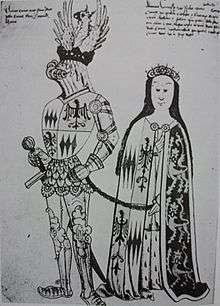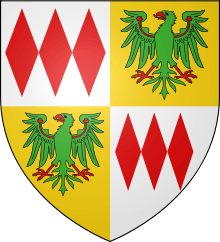Thomas Montagu, 4th Earl of Salisbury

Thomas Montagu, 4th Earl of Salisbury, 6th and 3rd Baron Montagu, 5th Baron Monthermer, and Count of Perche, KG (13 June 1388 – 3 November 1428) of Bisham in Berkshire, was an English nobleman and one of the most important English commanders during the Hundred Years' War.
Origins
He was the eldest son of John Montagu, 3rd Earl of Salisbury (d.1400), who was killed while plotting against King Henry IV in 1400, and his lands forfeited, later partly retrieved by Thomas. His mother was Maud Francis, daughter of Sir Adam Francis (born ca. 1334), Mayor of London.
Career

Thomas was summoned to Parliament as Earl of Salisbury in 1409, although he was not formally invested as earl until 1421. In 1414 he was made a Knight of the Garter. In July 1415 he was one of the seven peers who tried Richard, Earl of Cambridge on charges of conspiring against King Henry V. Montagu then joined King Henry V in France, where he fought at the Siege of Harfleur and at the Battle of Agincourt. Montagu fought in various other campaigns in France in the following years. In 1419 he was appointed lieutenant-general of Normandy and created Count of Perche, part of Henry V's policy of creating Norman titles for his followers. He spent most of the rest of his life as a soldier in France, leading troops in the various skirmishes and sieges that were central to that part of the Hundred Years' War. In 1425 he captured the city of Le Mans and fought at the Siege of Orléans in 1428 at which he lost his life.
Marriages & progeny
He married twice:
- Firstly to Eleanor Holland, a sister and eventual co-heiress of Edmund Holland, 4th Earl of Kent, and daughter of Thomas Holland, 2nd Earl of Kent. By Eleanor he had a daughter, his only legitimate child:
- Alice Montagu, who married Richard Neville, 5th Earl of Salisbury, who succeeded his father-in-law jure uxoris as Earl of Salisbury.
- Secondly to Alice Chaucer, daughter of Thomas Chaucer and grand-daughter of the poet Geoffrey Chaucer.
Death
On 27 October 1428 he was wounded during the Siege of Orléans, when the tower he was inside was hit by a cannonball. There are conflicting reports on the manner in which this wounded him; Enguerrand de Monstrelet states a piece of stone from the window 'carried away part of his face.' He died days later at Meung-sur-Loire on 3 November 1428.[2]
References
- Hunt, William (1894). "Thomas de Montacute or Montagu, fourth Earl of Salisbury". Dictionary of National Biography. 38: 208–211.
- the Peerage.com on Thomas Montagu, 4th Earl of Salisbury
- Cawley, Charles, Medieval Lands Project on Thomas de Montagu, Medieval Lands database, Foundation for Medieval Genealogy,
- de Monstrelet, Enguerrand (1440s). The Chronicles of Enguerrand de Monstrelet. VI. pp. 234–237.
External links
- Hundred Years War: Thomas Montacute, 4th Earl of Salisbury (1388–1428)
- Royal Berkshire History: Thomas Montacute, Earl of Salisbury (1388–1428)
| Political offices | ||
|---|---|---|
| Preceded by – |
Governor of Champagne 1423–1424 |
Succeeded by – |
| French nobility | ||
| Preceded by New creation |
Earl of Perche 1419–1428 |
Succeeded by extinct |
| Peerage of England | ||
| Preceded by John Montagu |
Baron Monthermer 1421–1428 |
Succeeded by Alice Montagu |
| Preceded by John Montagu |
Earl of Salisbury 1421–1428 |
Succeeded by Alice Montagu |
